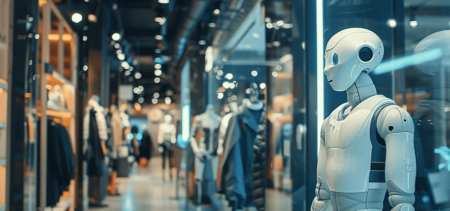Once the preserve of security services in airports, casinos or law enforcement agencies, state-of-the-art facial recognition solutions are now providing important use cases for the retail industry. By tracking customers, malls and retailers not only prevent losses from theft but can learn about customer demographics through real-time analysis of data about the shopper’s age, gender or even ethnicity.
A complete list of features
The basic task associated with facial recognition is the detection of frontal or near-frontal faces in a photo or a live stream. This is now done regardless of orientation, lighting conditions or skin color. For each individual, retailers get a complete analysis of facial landmarks: eyes, eyebrows, jaw, nose, and mouth.
The recognition process confirms someone’s identity by searching through millions of known faces in less than one second. For example, FaceFirst CEO Peter Trepp claims that the company’s solution “can match a face against the database of 25 million people in just under a second”.
Once detected, the faces can be classified depending on gender, age, emotion or ethnicity. This feature helps retail players design digital signage with real-time targeting. Built-in analytics generate the demographic make-up of people in a certain area, at a given time.
With the help of the counting feature, decision factors know exactly how many people have been detected within a given time frame. This is closely linked with classification and it works on both camera streams and groups of photos. The measure is simply statistical and helps managers to analyze customer behavior.
In the pursuit of identifying and rewarding loyal customers, managers now have a powerful tool on their hands. Returning or re-identification reveals how many times a person reappears after being identified once.
Better experiences for customers while maximizing the efficiency of security staff
Whereas normal surveillance cameras only offer information after crimes occur, data collected by real-time face recognition software is a source of proactive notifications. Such a system can prove to be a reliable way to prevent damage before it actually occurs. Any suspicious activity is recorded, archived and sent within seconds, thus reducing the response time. Furthermore, the technology enables video cameras to isolate and send a relevant selection of footage, considerably reducing the needed processing power required to handle the volumes of data generated.
In the search for a more positive retail experience, business managers can use real-time demographic tracking. Analytics and customer profiling brings to the table unprecedented insight into the habits and preferences of the store’s target audience. A detailed demographic breakdown (Who buys what and when?) allows a manager to adapt the size, skills and focus sales force available while crafting product displays that cater to specific parts of the audience at specific times. In addition, by correlating age and gender metrics with receipt timestamps, conclusions can be drawn about the products certain types of customers are more likely to buy, at what time of day and in what quantity.
Digital signage already proved its potential to maximize customer engagement and ad performance, but with the implementation of facial recognition, the game just got leveled up. Digital signage with facial recognition provides efficient real-time targeting, a dream for any advertiser.
GDPR and the processing of biometric data
While the collection of individuals’ biometric data is increasing and the manner in which it is processed continues to become more sophisticated, regulators are taking notice. The General Data Protection Regulation (GDPR) took an active approach with respect to the privacy of biometric data. GDPR singles out biometric data as a “sensitive” category of personal information, warranting robust protection. The GDPR defines biometric data as “personal data resulting from specific technical processing relating to the physical, physiological or behavioral characteristics of a natural person, which allow or confirm the unique identification of that natural person”. In many cases, it requires privacy impact assessments for its processing, and it empowers the Member States to pursue divergent protections for biometric data. As such, data controllers who are processing or may process biometric data should take note. According to the regulation, data processors must implement appropriate “technical and organizational measures” to keep data secure. Moreover, in the case of automated large-scale processing, or when data controllers monitor a publicly accessible area, privacy impact assessments are mandatory.
While civil libertarians raised their swords against the widespread use of facial recognition software, retailers have just started to dig into the honey pot and the industry will certainly adopt and exploit this new technology.































